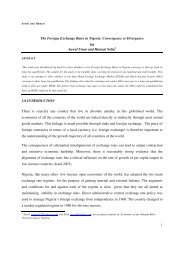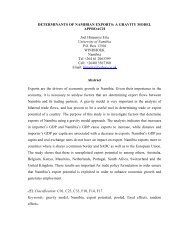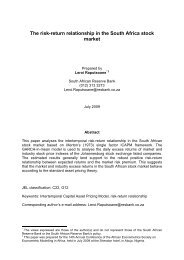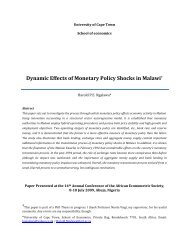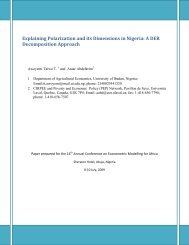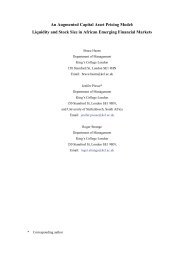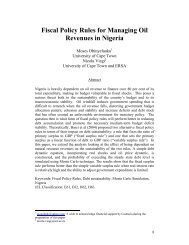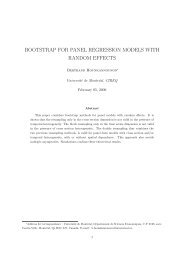Local government revenues and expenditures in Uganda: A VAR ...
Local government revenues and expenditures in Uganda: A VAR ...
Local government revenues and expenditures in Uganda: A VAR ...
Create successful ePaper yourself
Turn your PDF publications into a flip-book with our unique Google optimized e-Paper software.
III. Data <strong>and</strong> Empirical ResultsAnnual data for 56 local <strong>government</strong>s (districts) is used to exam<strong>in</strong>e the <strong>in</strong>terrelationshipsbetween <strong>government</strong> <strong>revenues</strong> <strong>and</strong> <strong>expenditures</strong>. These local <strong>government</strong> data are for theperiod 2001-2003 <strong>and</strong> are obta<strong>in</strong>ed from <strong>Local</strong> Government Returns published by theM<strong>in</strong>istry of F<strong>in</strong>ance, Plann<strong>in</strong>g <strong>and</strong> Economic Development. Prior to 2006, the majorsource of revenue for local <strong>government</strong>s <strong>in</strong> Ug<strong>and</strong>a was the graduated tax—apresumptive tax—levied on each adult Ug<strong>and</strong>a 1 . Other revenue sources for local<strong>government</strong>s <strong>in</strong> Ug<strong>and</strong>a <strong>in</strong>cluded property taxes, user fees <strong>and</strong> charges such as tourismtaxes (for <strong>in</strong>stance on recreational facilities such as beaches), taxes on the transportationof produce, urban authority permits, license fees <strong>and</strong> market dues.Due to unavailability of consistent <strong>and</strong> comparable local <strong>government</strong> data on<strong>expenditures</strong>, we use transfers from the central <strong>government</strong> to proxy for local <strong>government</strong><strong>expenditures</strong>. Such transfers <strong>in</strong>clude equalization transfers, funds for rural feeder roads,primary health care, agricultural extension (National Agricultural Advisory Services),UPE, <strong>and</strong> transfers to pay salaries. Though it is true that districts could use own generatedfunds to f<strong>in</strong>ance <strong>expenditures</strong> other than those covered under the local <strong>government</strong>transfers, we do not expect substantial deviations of the “actual” <strong>expenditures</strong> from local<strong>government</strong> transfers especially s<strong>in</strong>ce the majority of local <strong>government</strong>s <strong>in</strong> Ug<strong>and</strong>a relyon central <strong>government</strong> transfers to f<strong>in</strong>ance their programmes.An obvious advantage of us<strong>in</strong>g local <strong>government</strong> data is that they depict revenue <strong>and</strong>expenditure variations over time as well as across (districts) local <strong>government</strong>s. It isanticipated that the additional variation will improve the quality of the estimated revenueexpenditurerelationship.1. Tests for StationarityLiterature shows that us<strong>in</strong>g non-stationary data <strong>in</strong> causality tests could yield spuriouscausality results. As emphasized by Park (1998), we first perform unit root tests on ourvariables before proceed<strong>in</strong>g with the Granger-causality test so as to avoid the spuriousregression problem <strong>and</strong> to account for the appropriate dynamic specification. Stationarityof the variables was tested us<strong>in</strong>g the Augmented Dickey-Fuller (ADF) <strong>and</strong> the Phillips-Perron (PP) tests. However, these tests have been criticized for their limited ability todist<strong>in</strong>guish between series that are purely non-stationary processes <strong>and</strong> those with nearunit roots. Thus, we also run the KPSS (1992) test which has the null of stationarity. Asmentioned above, the optimal lag length of the tests is determ<strong>in</strong>ed us<strong>in</strong>g the Schwarz BICmodel selection criterion as recommended by Stock (1994).Table 1 shows that the ADF <strong>and</strong> PP tests allow for the rejection of the null hypothesis ofnon-stationarity for the levels of the variables while <strong>in</strong> the KPSS test we do not reject thenull hypothesis of stationarity for the levels of the variables. Consequently, we conclude1 Exceptions here <strong>in</strong>cluded the housewives, those serv<strong>in</strong>g <strong>in</strong> the armed forces <strong>and</strong> those under <strong>in</strong>carceration.3



